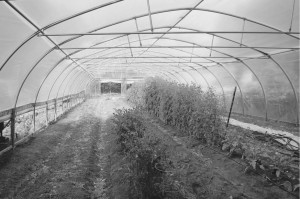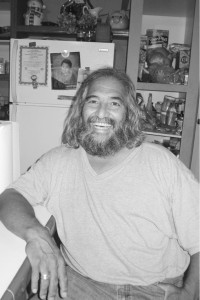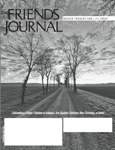A Conversation with New Mexico Farm Activist Don Bustos

Don Bustos is a New Mexican farmer who has helped build a farming program through American Friends Service Committee. AFSC’s New Mexico program trains beginner farmers in sustainable agricultural practices and has set up a distribution system, Agri-Cultura Network, to aggregate the farmers’ produce to attract institutional buyers like the Albuquerque and Santa Fe public schools.
Don’s approach is to meet the needs of the community while also taking on more systemic problems. At both state and federal levels, Don Busto advocates for farm policy that prioritizes underserved, small farmers who use sustainable practices. I had the chance to talk to Don recently about his farm and how it relates to his activism and spirituality.
Lucy Duncan (LD): Tell me the history of your farm.

Don Bustos (DB): The name of our farm is Santa Cruz Farm. It is named after our church—the Santa Cruz Church—whose name traces back to the Santa Cruz de la Canada Land Grant. I farm the same land my ancestors farmed over three hundred years ago. As you walk outside, you’ll see the same land, the same crops, and the same methods that my ancestors used. We pass on knowledge of ancestral practices to the trainee farmers, incorporating a little new technology that allows us to grow produce year round; for example, we use solar energy in cold frames.
We reconstituted the land grant here several years ago and were acknowledged by the state attorney general. Our vision is to move from land that has been designated for agricultural purposes (where we’ve been forced by the U.S. government to put our houses and communities) and to return to the original design of the settlers, which would allow more free space for growing food. That’s a long-term, multi-generational vision that we work on. The original grant was 44,600 acres, and we have been able to petition the state to acquire some of this land. We want to expand so that families will build housing and the whole community can grow their food, have their jobs, and feed their kids in a sustainable system. We’re talking about revitalizing the old food system and making it work for hundreds of years to come, so we don’t need to rely much on outside food production.
We still irrigate with our ancient acequia system that was dug hundreds of years ago. Ours here is earth dug and hasn’t changed except for the pathway of the water itself. We irrigate off the Santa Cruz River, and our acequia is called the Santa Cruz acequia. We have a small, communal reservoir that the community—not the government—financed and built in the 1920s. [Water rights are closely linked to farming in the New Mexico program and are regulated by commissions. Because water is scarce, there are folks interested in encroaching on the water rights, but if people who hold the rights can demonstrate that they use the water beneficially, as in farming, they can retain their access.—Lucy Duncan]
We’ve known for hundreds of years how to sustain our community through producing our food, and we want to preserve that knowledge so future generations will know its importance and can continue. If you grow your food and grow your own seeds, you’re a free person; you don’t become a slave to the food system, working and buying food at any price that’s mandated. To us, it’s an empowerment issue. It’s a human right to be able to grow our own food and to access good water, fairly and equitably. We’re training people in the business of sustainable agriculture. Our job is to give them the tools; they then learn to make critical decisions to protect their land and water, as successful business people.
LD: Successful, but they’re also collaborative.
DB: It’s about communal development. For example, if we’re considering how we can meet the needs of institutional buyers by aggregating our product, we need to work together. That means getting people to sit down at the table when they sometimes have differences, to discuss, and then to figure out that the best solution is to work together to create a food system that allows the whole community to flourish.
We AFSC workers go into the community saying that we don’t know everything, but with their help, we’ll all learn. Then after three years, AFSC walks away: win, lose, or draw; it’s up to our trainees to take over the work and run with it. That transition is happening now in Albuquerque. At first it’s a little rocky, and they want us there, but then they say, “How come you’re still here?”
LD: The model you work on seems based on learning by doing—that people see the alternative by building it. That is powerful.
DB: People are asking us to replicate the model. I’ve been traveling out to Indian country, up in Navajo area, to the Dine, and Hopi; we’re trying to figure out how to partner with them. We hope to go to the next stage and continue to use this model. At some point in the future, we can go the United States Department of Agriculture and set up a federal program that will put resources in place for aggregation within underserved communities. We could actually have a piece of legislation that all of us could work to get passed. That won’t happen until 2016 or 2020, but we’re laying the groundwork now.
LD: Sayrah Namaste, the New Mexico program co-director, was telling me that people want this program because it is an economic alternative to joining the military.
DB: New Mexico has a 48 percent dropout rate from high school. When I was growing up, the military was the one economic option. In Chaparral, they are recruiting very young men and women, but now these young people see another possibility in farming. This is also an alternative for formerly incarcerated people.
LD: The potential for transformation is incredible. Fidel [a trainee] was talking about creating an investment pool that is shared by the community, which would give more independence to grow what the community needs as well as what the market demands.
DB: We’re not only creating an alternative food system but also an alternative financing system. Many people in the community wouldn’t qualify for traditional loans. We want financial institutions developed that are flexible about loaning money, so that it circulates within the community. We researched and found that a dollar circulates 3.4 times in a typical community. We’ve adopted models, such as micro-loans, that let that dollar circulate 6.8 times. The whole idea is to get healthful food to kids in order to create healthy communities.
LD: At some point you were using pesticides, and you stopped.
DB: In the 1960s, we were still farming naturally. In 1967, an agricultural agent came by and gave my dad a bottle of liquid. I learned later that it was DDT. He mixed it with water. That year we had perfect corn—no worms. So my dad started using chemical fertilizers and insecticides, all approved by USDA.
When the economy slowed in the 1980s, I started to do more farming. I grew pumpkins and corn and used an insecticide called Sevin that came in a dust form. I was growing the best pumpkins in northern New Mexico. For six weeks I would go out and spread the Sevin dust, and it would kill all the squash bugs. I’d go to the farmers’ markets in the morning; then I’d take a little nap; then in the evening, I’d go out and do a little dusting.
One evening I came back home after dusting. My son was a one-year-old infant at the time, and he started to roll on the floor behind me. I imagined him rolling in the dust that had come off my pants leg. It dawned on me: I’m poisoning the bugs out there; I don’t need to be poisoning my kids. That’s when I started to learn to grow organic and moved from a chemical-based agricultural system back to an organic system. We’ve been certified organic since the 1980s.
LD: What changes have you witnessed in the communities in which you’ve worked?
DB: People used to say that the model I’d created depended on me. I told them, “If that’s true, then the model’s not working.”
In Las Cruces in Chapparal, we’re working with a group of immigrant growers. They’re forming a cooperative and have created a little farm in the middle of the desert. It’s mostly women who have really come into the project; we’re hearing their voices more and more. They are growing food, and they are going to the markets and speaking. I did a study with Oxfam International about the people that we work with; they get less than 1 percent of all the federal resources from the USDA, yet represent 15 percent of the growers.
LD: Your work is very practical and empowering. Would you mind talking a bit about the spiritual aspects?
DB: The spiritual is part of everything we do. When we plant, we do a blessing that acknowledges the Creator: “One for the Creator, one for the neighbor, and one for everything living.” In the spring, the priest blesses the waters, or rather acknowledges that the waters are blessed. That is a ritual in our tradition that allows us to go forward and plant our seeds. On our farm, we have a bean called a Virgin Mary bean. It’s planted on the corners of the farm and protects it from bad weather. Part of our teaching is about planting by the moon’s cycles.
We also do a dance, acknowledging our need for permission to plant or work in the fields. When farmer trainees Fidel, Joseph, and Jeff were going through our training program, we’d all work together, going from one farm to the next. We’d first establish a farm and plant the seeds, and then we’d move on to another and do the same thing. Eventually, I began to notice that the crops were growing faster at Fidel’s farm. I asked him, “What are you doing; are you using Miracle-Gro or something?” He said, “No, we have our dances in our greenhouses, and before we plant or work in the fields, we ask permission.”
LD: Quaker testimonies are very evident. How do they undergird your work?
DB: I think we work within the Quaker principles. Simplicity is the basis for our program: how much do you need to support your family? Community is also a part of it: we are part of a bigger creation, and we are part of a bigger whole. I don’t make decisions alone; we all contribute, which is why our program is so effective. It’s all of us figuring out what the next steps are. Our program is really based on social change through nonviolence. We inherently live with Quaker values. Acknowledging the Creator, the Earth, and how we all work together is an important part of our work. There is no other way.



Comments on Friendsjournal.org may be used in the Forum of the print magazine and may be edited for length and clarity.